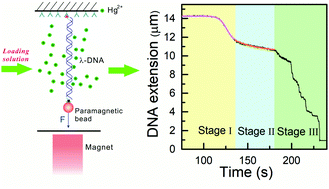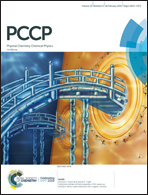Multistage dynamics of Hg2+–DNA interactions: a single-molecule study
Abstract
The metal ion–DNA interaction is key to biochemical processes and has applications in areas such as metal ion sensors and DNA nanomachines. For example, the formation of the T–Hg2+–T structure has been used in technologies such as DNA-based mercuric ion sensors. Though the interaction is widely used for practical purposes, the underlying mechanism has not been fully understood. In the present study, we used magnetic tweezers to explore the interactions between λ-DNA and two metal ions, Hg2+ and Cd2+, at the single-molecule level. Both metal ions caused considerable DNA conformational changes. The resulting DNA compaction dynamics were related to the ion concentration and the exerted force. The increase in the ion concentration promoted DNA compaction, whereas exerting greater forces inhibited this process. Application of a high force generated two-stage dynamics of the Hg2+–DNA interaction. However, at a sufficiently high Hg2+ concentration, a lower force led to a three-stage process. In contrast, the curves of the binding of Cd2+ ions to DNA had a stepwise pattern. Both the AFM scanning results and the single-molecule measurements confirmed that Hg2+ influences the DNA conformation in a more pronounced manner than Cd2+. The multistage Hg2+–DNA interaction was considered to be a result of the different binding mechanisms, including the mismatched base-pair formation. A model was then proposed to explain the peculiar dynamics.

- This article is part of the themed collection: 2019 PCCP HOT Articles


 Please wait while we load your content...
Please wait while we load your content...